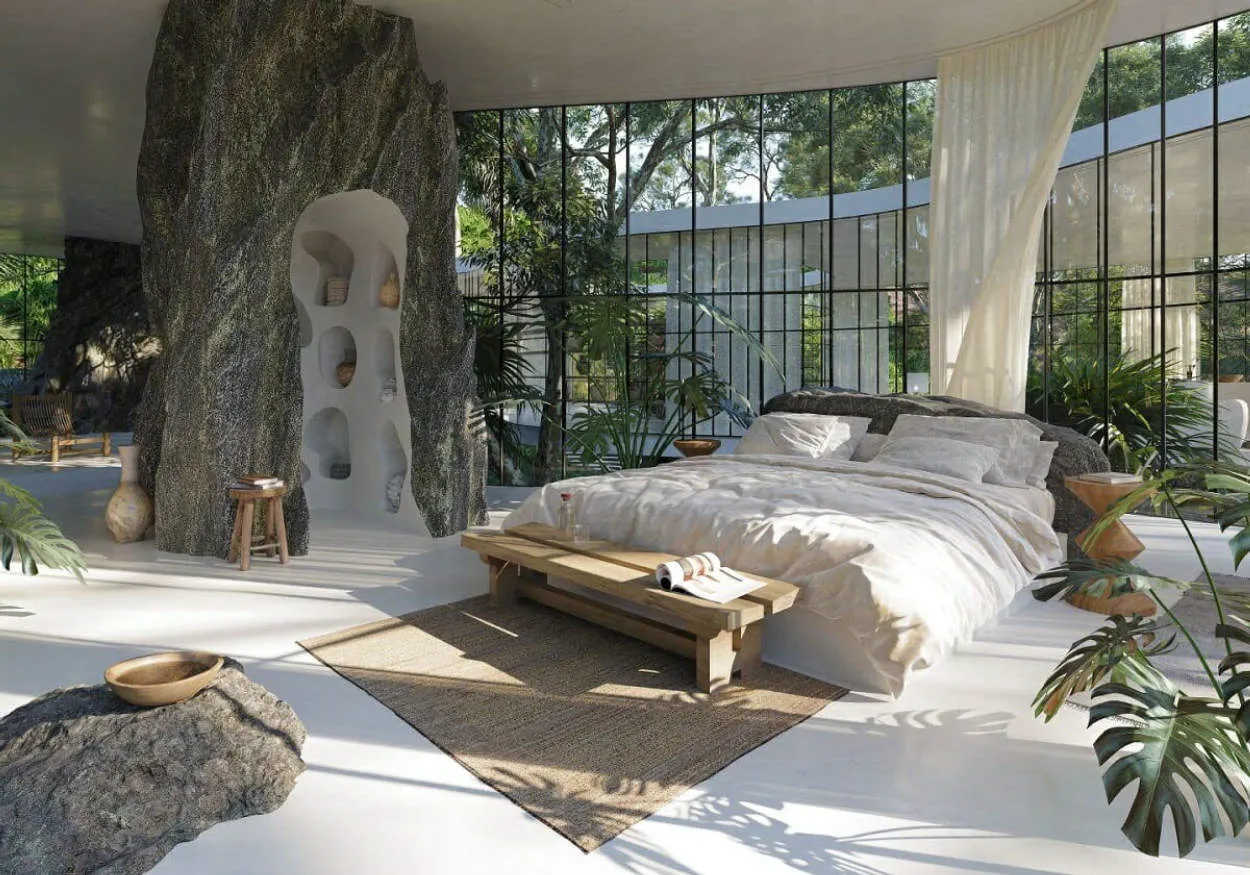Creating a biophilic bedroom allows you to bring the calming and rejuvenating touch of nature indoors. From incorporating plants and natural materials to utilizing natural light and soothing colors, discover how to transform your bedroom into a serene oasis that promotes well-being and connection with the natural world.
Principles of Biophilic Design
Biophilic design is an approach to architecture and interior design that seeks to incorporate nature and natural elements into living spaces. By integrating natural elements, it aims to create environments that enhance our connection with nature and promote overall well-being. When it comes to designing a biophilic bedroom, several principles should be considered:
1. Natural Lighting
Allowing ample natural light to enter the bedroom not only brightens up the space but also improves mood and circadian rhythm. Maximize the use of windows and skylights to bring in sunlight and create a connection with the outside environment.
2. Indoor Plants
Introduce indoor plants to your bedroom. They not only add a touch of greenery but also contribute to better air quality by absorbing carbon dioxide and releasing oxygen. Choose low-maintenance plants that thrive in indoor environments.
3. Natural Materials
Incorporate natural materials into the bedroom design, such as wooden furniture, flooring, or wall finishes. These materials create a sense of warmth and bring a natural element to the space.
4. Views of Nature
If possible, create views of nature from the bedroom. Position your bed near a window with a scenic view or hang nature-inspired artwork on the walls. These elements can evoke a sense of calmness and tranquility.
5. Water Features
Consider adding a small water feature, like a tabletop fountain or a wall-mounted waterfall, to your biophilic bedroom. The sound of flowing water can help induce relaxation and create a soothing atmosphere.
6. Natural Colors and Patterns
Choose a color palette inspired by nature, such as earth tones, greens, and blues. Incorporate natural patterns and textures in textiles, wallpapers, or artwork to further enhance the biophilic design.
7. Sensory Stimulation
Engage multiple senses by incorporating sensory elements in the bedroom. Install a wind chime for gentle sounds, use soft and natural fabrics for tactile sensations, and introduce natural scents through candles or essential oils.
8. Sustainable Design
Embrace sustainability in your biophilic bedroom design. Choose eco-friendly materials, opt for energy-efficient lighting, and consider using reclaimed or recycled elements whenever possible.
Creating a biophilic bedroom that embraces these principles can transform your space into a peaceful sanctuary that fosters relaxation, connection with nature, and overall well-being.
Natural Material Selection
When it comes to creating a biophilic bedroom and bringing nature’s touch indoors, one crucial aspect to consider is the selection of natural materials. By incorporating natural materials into your bedroom design, you can enhance the connection to nature and create a calming and rejuvenating space.
Start by opting for wooden furniture, such as a bed frame or side tables, as wood provides a warm and organic feel to the room. Additionally, consider using natural fibers for your bedding and curtains, such as cotton or linen, as they are breathable and promote a restful sleep.
Introduce plants into your bedroom to bring nature closer to you. Not only do plants improve indoor air quality, but they also add a touch of greenery and tranquility. Choose low-maintenance plants like snake plants or peace lilies that thrive in indoor environments.
Another way to incorporate natural material is through the use of stone or ceramic accessories. From a stone vase to ceramic bowls, these elements can add texture and earthiness to your bedroom decor.
Lastly, don’t forget to let in natural light. Maximize the amount of natural light entering your bedroom by keeping windows unobstructed or using sheer curtains. Natural light not only brightens up the space but also creates a connection with the outdoors.
Plant Life in Bedrooms
A biophilic bedroom embraces the concept of bringing nature indoors. By incorporating plants into your bedroom design, you can create a tranquil and soothing environment that promotes relaxation and improves air quality.
Natural Beauty and Serenity
Plants add a touch of natural beauty to any room, and the bedroom is no exception. Incorporating greenery into your sleeping space can promote a sense of serenity and calm, making it the perfect sanctuary for a good night’s sleep.
Air Purification
Plants are known for their air-purifying abilities. By releasing oxygen and absorbing carbon dioxide, they help improve indoor air quality. Having plants in your bedroom can increase humidity, reduce toxins, and even filter out harmful chemicals.
Reduced Stress and Increased Productivity
Research shows that being around plants can reduce stress levels and promote a sense of well-being. Having a biophilic bedroom with plants can help you unwind after a long day and improve your overall mood. Additionally, being in a green environment has been linked to increased productivity and creativity.
Choosing the Right Plants
When selecting plants for your bedroom, consider ones that thrive in low-light conditions and have air-purifying properties. Some popular choices include snake plants, pothos, peace lilies, and ZZ plants. These plants are known for their ability to tolerate indoor environments and require minimal care.
Caring for Your Bedroom Plants
Proper care is essential to ensure your bedroom plants thrive. Be sure to provide adequate water, sunlight, and ventilation. Regularly dust the leaves to prevent dust buildup, which can hinder their ability to photosynthesize effectively.
In conclusion,
Creating a biophilic bedroom by incorporating plants can enhance the overall ambiance and well-being of your sleeping space. Not only do plants add natural beauty and serenity, but they also contribute to air purification, stress reduction, and increased productivity. Selecting the right plants and providing proper care are crucial for ensuring their longevity and benefits.
Maximizing Natural Light
In the pursuit of creating a biophilic bedroom, one essential element to consider is maximizing natural light. The presence of natural light has a profound impact on our well-being and the overall ambiance of a space.
Firstly, natural light contributes to the circadian rhythm, the internal clock that regulates our sleep-wake cycle. Exposure to natural light during the day helps to regulate our internal clock, leading to improved sleep quality at night.
In addition to its influence on sleep, natural light also enhances the visual appeal of a biophilic bedroom. The play of light and shadow creates an inviting and serene atmosphere, bringing a touch of nature indoors.
There are several strategies to maximize natural light in your bedroom. Start by choosing light-colored curtains or blinds that allow sunlight to filter in. Avoid heavy, opaque window coverings that block natural light. Additionally, keeping windows clean and unobstructed can significantly improve the amount of light that enters the space.
If privacy is a concern, opt for sheer curtains or window films that maintain privacy while still allowing ample natural light to pass through. Another option is to position mirrors strategically to reflect and amplify natural light throughout the room.
Lastly, consider the layout and positioning of furniture in your biophilic bedroom. Arrange furniture in a way that maximizes access to natural light. Ensure that windows are not blocked by large objects, allowing light to flow freely into the room.
Earthy Color Palettes
In creating a biophilic bedroom, incorporating earthy color palettes can bring the soothing touch of nature indoors. Earthy tones such as warm browns, soft greens, and shades of beige evoke a sense of calm and serenity, creating a peaceful atmosphere within your bedroom.
When choosing earthy colors, consider using natural materials such as wooden furniture and flooring to complement the palette. These natural elements not only add visual appeal but also contribute to a more sustainable and eco-friendly bedroom.
You can experiment with different combinations of earthy colors to suit your personal taste and style. For a rustic and cozy feel, pair darker shades of brown with hints of green. Alternatively, opt for lighter tones such as creamy whites and soft sands for a bright, airy, and minimalist look.
Integrating earthy color palettes in your bedroom can have numerous benefits. They promote relaxation, reduce stress levels, and create an environment that is both grounding and restorative. By bringing nature’s touch indoors, your biophilic bedroom becomes a sanctuary where you can unwind and reconnect with the natural world.
Conclusion
In conclusion, creating a biophilic bedroom by incorporating elements of nature indoors can have significant benefits for our well-being. From improving air quality and sleep quality to reducing stress and boosting creativity, the presence of nature in our living spaces is essential. By bringing in plants, natural materials, and natural light, we can create a more harmonious and calming environment that enhances our connection to the natural world.




